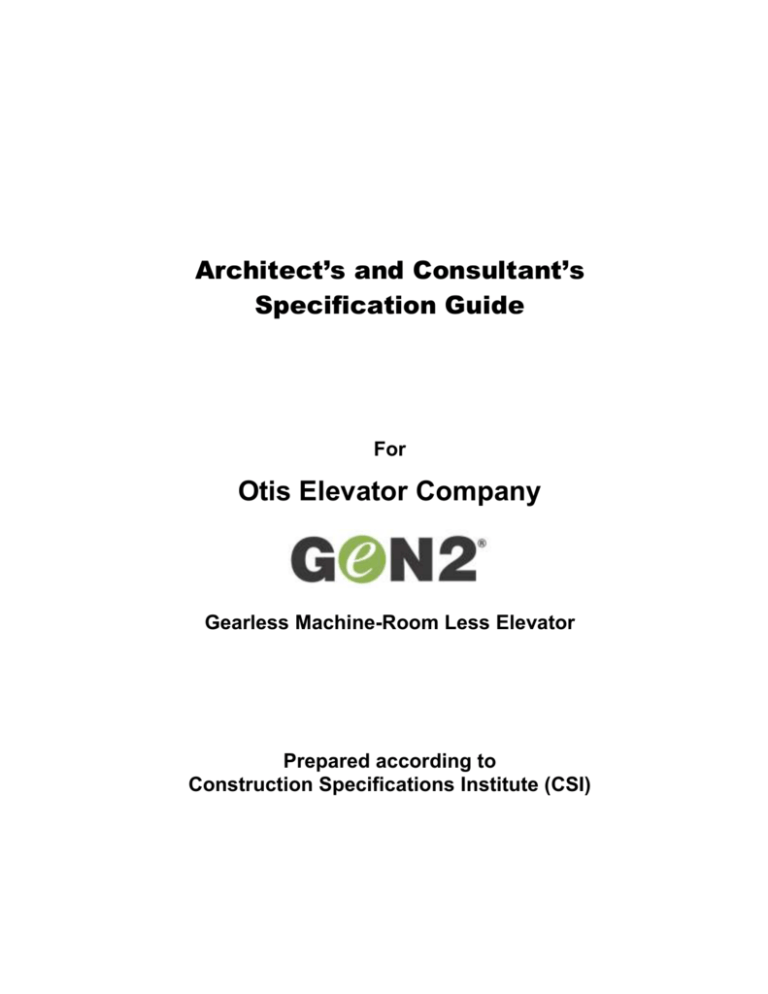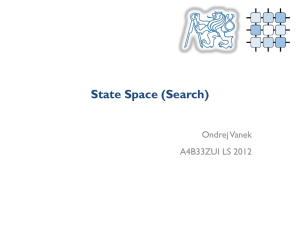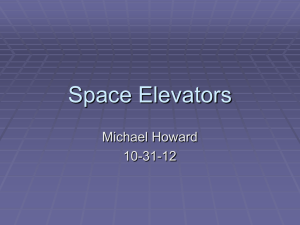
Architect’s and Consultant’s
Specification Guide
For
Otis Elevator Company
Gearless Machine-Room Less Elevator
Prepared according to
Construction Specifications Institute (CSI)
ELEVATORS 14210 – Guide Specifications for Gen2® Gearless Machine–Room Less Elevator
SECTION 14210 – Electric Traction Elevators
PART 1 - GENERAL
1.01
SUMMARY
A.
This Section specifies electric traction elevators.
B.
Work Required:
1. The work required under this section consists of all labor, materials and services required for
the complete installation (including operational verification) of all the equipment required for
the elevator(s) as herein specified.
2. All work shall be performed in a first class, safe and workmanlike manner.
3. In all cases where a device or part of the equipment is herein referred to in the singular, it is
intended that such reference shall apply to as many of such devices or parts as are required
to make complete installation.
C.
Related work not specified herein: The following sections contain requirements that relate to this
section and are performed by trades other than the elevator manufacturer/installer.
1. Section 01500 - Construction Facilities and Temporary Controls: protection of floor openings
and personnel barriers; temporary power and lighting.
2. Section 02200 - Earthwork: excavation for elevator pit.
3. Section 03300 - Cast-In-Place Concrete: elevator pit, and elevator machine foundation.
4. Section 04200 - Unit Masonry: masonry hoistway enclosure, building-in and grouting hoistway
doorframes, and grouting of sills.
5. Section 05500 - Metal Fabrications: pit ladder, divider beams, and supports for entrances,
rails and hoisting beam at top of elevator hoistway.
6. Section 07145 - Cementitious Waterproofing: waterproofing of elevator pit.
7. Section 15500 - Heating, Ventilating, and Air Conditioning: ventilation and temperature control
of elevator equipment areas.
8. Section 16100 - Electrical:
a. Main disconnects for each elevator.
b. Electrical power for elevator installation and testing.
c. Disconnecting device to elevator equipment prior to activation of sprinkler system.
d. The installation of dedicated GFCI receptacles in the pit and overhead.
e. Lighting in controller area, machine area and pit.
f. Wiring for telephone service to controller.
9. Section 16610 – Emergency (Standby) Power Supply Systems: emergency generator for
elevator operation.
10. Section 16720 - Fire Alarm Systems: The installation of fire and smoke detectors at required
locations and interconnecting devices; fire alarm signal lines to contacts in the machine area.
11. Section 16740 - Telephone Systems: ADAAG-required emergency communications
equipment.
D.
Applicable Codes: Comply with applicable building and elevator codes at the project site, including
but not limited to the following:
1. ANSI A117.1, Buildings and Facilities, Providing Accessibility and Usability for Physically
Handicapped People.
2. ADAAG, Americans with Disabilities Act Accessibility Guidelines.
3. ANSI/NFPA 70, National Electrical Code.
14210 - 1
Gen2® Gearless Machine-Room Less Elevator
ELEVATORS 14210 – Guide Specifications for Gen2® Gearless Machine–Room Less Elevator
4.
5.
6.
7.
8.
9.
ANSI/NFPA 80, Fire Doors and Windows.
ASME/ANSI A17.7, Safety Code for Elevators and Escalators.
ANSI/UL 10B, Fire Tests of Door Assemblies.
CAN/CSA C22.1, Canadian Electrical Code.
CAN/CSA-B44, Safety Code for Elevators and Escalators.
EN 12016 (May 1998): “EMC Product Family Standards for lifts, escalators, and passenger
conveyors Part 2 – immunity”
10. Local Building Codes
11. All other local applicable codes.
[NOTE: EDIT ITEMS SHOWN IN [BOLD] TEXT]
1.02
SYSTEM DESCRIPTION
Note: Create separate sections, each containing the following parameters, if a group contains more than one
system configuration.
A.
Equipment Description: Gen2® gearless traction elevator with [Select One] Machine Room or
Machine Room-less application.
B.
Equipment Control: Elevonic® Control System.
C.
Quantity of Elevators: [Enter appropriate number, 8 max]
D.
Elevator Stop Designations: [Enter Appropriate elevator designations]
E.
Stops (maximum): [200 fpm] 21 or [350 fpm] [400 fpm] [450 fpm] [500 fpm]36
F.
Openings: [Select one] In line or Front & rear openings.
G.
Travel (maximum): [200 fpm] 196 ft (60 m) or [350 fpm] [400 fpm] [450 fpm] [500 fpm] 300 ft.
(92 m)
H.
Rated Capacity: [Select one] 2500 lb., 3000 lb., 3500 lb. 4000 lb., 4500 lb. 5000 lb.
I.
Rated Speed: [Select one] 200 fpm or 350 fpm, 400 fpm, 450 fpm, 500 fpm
J.
Platform Size: [2500] 6’ 9-1/2” W x 4’ 3-3/4” D
[3000] 6’ 9-1/2” W x 4’ 9-9/16” D
[3500] 6’ 9-2/2” W x 5’ 5-9/16” D
[4000] 7’ 9-1/2” W x 5’ 5-9/16” D
[4000H] 5’ 9-1/2” W x 7’ 5-5/8” D
[4500H] 5’ 9-1/2” W x 7’ 11-9/16” D
[5000H AIA] 5’ 9-1/2” W x 9’ 0-9/16” D
[5000H] 6’ 0-1/2” W x 8’ 6-9/16” D
K.
Clear Inside Dimensions: [2500 lb.] 6’ 8-5/16” W x 4’ 3-5/32” D
[3000] 6’ 8-5/16” W x 4’ 9” D
[3500] 6’ 8-5/16” W x 5’ 5” D
[4000] 7’ 8-5/16” W x 5’ 5” D
[4000H] 5’ 8-5/16” W x 7’ 5-1/16” D
[4500H] 5’ 8-5/16” W x 7’ 11” D
[5000H AIA] 5’ 8-5/16” W x 9’ 0” D
[5000H] 5’ 11-5/16” W x 8’ 6” D
L.
Cab Height: [Select one] 8’ 0” or 9’ 7”
M.
Clear height under suspended ceiling: [8’ 0”] 7’ 4-3/4” (2246 mm) [9’ 7”] 8’ 11-3/4” (2813mm)
14210 - 2
Gen2® Gearless Machine-Room Less Elevator
ELEVATORS 14210 – Guide Specifications for Gen2® Gearless Machine–Room Less Elevator
N.
Entrance Type and Width:
[2500] Single-Slide Door 3’ 6” (1067 mm)
[2500] Center-Open Doors 3’ 6” (1067 mm)
[3000] Single-Slide Doors 3’ 6” (1067 mm)
[3000] Center-Open Doors 3’ 6” (1067 mm)
[3500] Single-Slide Doors 3’ 6” (1067 mm)
[3500] Center-Open Doors 3’ 6” (1067 mm)
[4000] Center-Open Doors 4’ 0” (1219 mm)
[4000H] Two-Speed Doors 4’ 0” (1219 mm)
[4500H] Two-Speed Doors 4’ 0” (1219 mm)
[5000H] Two-Speed Doors 4’ 6” (1372 mm)
[5000H AIA] Two-Speed Doors 4’ 0” (1219 mm)
O.
Entrance Height: [Select one] 7’ 0” (2134 mm) or 8’ 0” (2438mm)
P.
Main Power Supply: [Select one] 208, 220, 230, 240, 440, 460, 480, 550, 575, or 600 Volts + or 5% of normal, three-Phase, with a separate equipment grounding conductor.
Q.
Car Lighting Power Supply: 120 Volts, Single-phase, 15 Amp, 60 Hz.
R.
Machine Location: [Machine Room-Less] Inside the hoistway at the top or [Machine Room]
Inside machine room above hoistway.
S.
Signal Fixtures: Manufacturer’s standard.
T.
Controller Location: [Machine Room-Less] Controller(s) shall be located adjacent to the hoistway
at the top landing in a [select one <controller space.> or <control room.> or < remote controller
space.> or < remote control room.>]
[OR]
[Machine Room] Controller(s) shall be located above the hoistway in a machine room.
U.
Performance:
1. Car Speed: + 3 % of contract speed under any loading condition or direction of travel.
2. Car Capacity: Safely lower, stop and hold up to 125% of rated load. (code required).
V.
Ride Quality:
1.
2.
3.
4.
5.
6.
7.
W.
Vertical Vibration (maximum): 12 – 17 milli-g
Horizontal Vibration (maximum): 10 – 15 milli-g
Vertical Jerk (maximum): 4.6 1.0 ft./ sec3 (1.4 0.3 m/ sec3)
Acceleration/Deceleration (maximum): 2.6 .33 ft./ sec2 (0.8 0.13 m/ sec2)
In Car Noise: 50 – 55 dB(A)
Stopping Accuracy: 0.2 in. ( 5 mm)
Re-leveling Distance: 0.4 in. ( 10 mm)
Operation:
[Simplex] Simplex Collective Operation: Using a microprocessor-based controller, operation shall
be automatic by means of the car and hall buttons. If all calls in the system have been answered,
the car shall park at the last landing served.
[OR]
[Duplex] Duplex Collective Operation: Using a microprocessor-based controller, the operation
shall be automatic by means of the car and hall buttons. In the absence of system activity, one car
can be made to park at the pre-selected main landing. The other (free) car shall remain at the last
landing served. Only one car shall respond to a hall call. If either car is removed from service, the
other car shall immediately answer all hall calls, as well as its own car calls.
14210 - 3
Gen2® Gearless Machine-Room Less Elevator
ELEVATORS 14210 – Guide Specifications for Gen2® Gearless Machine–Room Less Elevator
[OR]
[Multi-car] Multi-Car (3 to 8 cars) Operation: Using a microprocessor-based controller, the
operation shall be automatic by means of the car and hall buttons. In the absence of system
activity, one car can be made to park at the pre-selected main landing. The other (free) cars shall
park in multiple zones, changing their location with traffic demands.
X.
Operating Features – Standard
1.
2.
3.
4.
5.
6.
7.
Full Collective Operation
Anti-nuisance.
Fan and Light Protection.
Load Weighing Bypass.
Independent Service.
Full Collective Operation.
Firefighters' Service Phase I and Phase II (USA only); or Special Emergency Service Phase I
and II – Emergency Recall and In-Car Emergency Operation (Canada only).
8. Top of Car Inspection.
[Include the following operations for duplex or multi-car Operation, delete for Simplex.]
9. Zoned Car Parking.
10. Relative System Response Dispatching.
11. MRO Manual Rescue Operation
Y.
Operation Features – Optional
[Include the following options as required. Renumber accordingly.]
1. Car to Lobby Operation.
2. Zoned Access at Bottom Landing.
3. Zoned Access at Upper Landing.
4. Car Secure Access.
5. Provision for Card Reader in Car (Card Reader provided and Installed by others).
6. Express Priority Service with key-switch(es) at [enter landing designation(s)]
7. Second Riser of Hall Buttons.
8. Emergency Hospital Service.
9. Automatic Rescue Operation
10. Automatic Standby Power Operation with Manual Override.
This operation shall return each car automatically to a designated landing when the system is
initially switched to standby power. One or more cars are returned at a time. Preference is given
to loaded cars over empty cars in order to reduce passenger wait times. A car must respond by
beginning to move toward the designated landing within a pre-determined time. If a car does not
respond, it is automatically placed in a "Not Available" mode while other cars are moved. If a car
was not returned to the designated landing on the first try, a second attempt is made. If the
second attempt is not successful, the car will remain in a "Not Available" mode and can only be
moved by manual means. Once each car has returned to the designated landing, the doors will
remain open for a predetermined amount of time.
When all cars have successfully returned to the designated landing or have attempted to move
twice, automatic selection of the car(s) to run on normal operation will occur.
If for any reason a car selected for normal operation under standby power is delayed for 60
seconds, the car will be placed in a "Not Available" mode and another car will be selected for
normal operation based on the priorities listed above.
14210 - 4
Gen2® Gearless Machine-Room Less Elevator
ELEVATORS 14210 – Guide Specifications for Gen2® Gearless Machine–Room Less Elevator
Manual Override of Standby Power Operation is achieved by a manual input for each car via a
strip switch. A manually selected car may be run either in a return operation to a designated
landing or in normal operation under standby power. If a manually selected car has not yet
returned to the designated landing, it will perform this operation first then immediately go into
normal operation.
If a manually selected car is delayed, no other car can be selected in the group unless it is
manually selected.
If car selection is changed by Manual Override while a car is running in return or normal operation
under standby power, the newly selected car will not be permitted to run until the car that had
been running has stopped, opened its doors, and gone into the Standby Power Wait state.
Z.
Door Control Features:
1. Door control to open doors automatically when car arrives at a landing in response to a
normal hall or car call.
2. Elevator doors shall be provided with a reopening device that will stop and reopen the car
door(s) and hoistway door(s) automatically should the door(s) become obstructed by an
object or person.
Primary door protection shall consist of a two dimensional, multi-beam array projecting across
the car door opening.
3. Door nudging operation to occur if doors are prevented from closing for an adjustable period
of time.
AA.
1.03
1.04
Provide equipment according to seismic zone: [Enter appropriate zone for project: 0, 1, 2, 3, 4,
California Title 24]
SUBMITTALS
A.
Product Data: Submit manufacturer’s product data for each system proposed for use. Include the
following:
1. Signal and operating fixtures, operating panels and indicators.
2. Cab design, dimensions and layout.
3. Hoistway-door and frame details.
4. Electrical characteristics and connection requirements.
5. Expected heat dissipation of elevator equipment in hoistway (BTU).
6. Color selection chart for Cab and Entrances.
B.
Shop Drawings: Submit approval layout drawings. Include the following:
1. Car, guide rails, buffers and other components in hoistway.
2. Maximum rail bracket spacing.
3. Maximum loads imposed on guide rails requiring load transfer to building structure.
4. Clearances and travel of car.
5. Clear inside hoistway and pit dimensions.
6. Location and sizes of access doors, hoistway entrances and frames.
C.
Operations and Maintenance Manuals: Provide manufacturer's standard operations and
maintenance manual.
QUALITY ASSURANCE
14210 - 5
Gen2® Gearless Machine-Room Less Elevator
ELEVATORS 14210 – Guide Specifications for Gen2® Gearless Machine–Room Less Elevator
1.05
A.
Manufacturer: Elevator manufacturer shall be ISO 9001 certified.
B.
Installer: Elevators shall be installed by the manufacturer.
C.
Permits, Inspections and Certificates: The Elevator Contractor shall obtain and pay for necessary
Municipal or State Inspection and permit as required by the elevator inspection authority, and
make such tests as are called for by the regulations or such authorities. These tests shall be
made in the presence of such authorities or their authorized representatives.
DELIVERY, STORAGE AND HANDLING
A.
Should the building or the site not be prepared to receive the elevator equipment at the agreed
upon date, the General Contractor will be responsible to provide a proper and suitable storage
area on or off the premises.
Should the storage area be off-site and the equipment not yet delivered, then the elevator
contractor, upon notification from the General Contractor, will divert the elevator equipment to the
storage area. If the equipment has already been delivered to the site, then the General
Contractor shall transport the elevator equipment to the storage area. The cost of elevator
equipment taken to storage by either party, storage, and redeliver to the job site shall not be at the
expense of the elevator contractor.
1.06
WARRANTY
A.
1.07
The elevator contractor’s acceptance is conditional on the understanding that their warranty
covers defective material and workmanship. The warranty period shall not extend longer than one
(1) year from the date of completion or acceptance thereof by beneficial use, whichever is earlier,
of each elevator. The warranty excludes: ordinary wear and tear, improper use, vandalism,
abuse, misuse, or neglect or any other causes beyond the control of the elevator contractor and
this express warranty is in lieu of all other warranties, express or implied, including any warranty
of merchantability or fitness for a particular purpose.
MAINTENANCE and SERVICE
A.
Maintenance service consisting of regular examinations and adjustments of the elevator
equipment shall be provided by the elevator contractor for a period of [Select the appropriate
new installation maintenance period: <three (3)> <six (6)> <nine (9)> <twelve (12)>] months
after the elevator has been turned over for the customer’s use. This service shall not be
subcontracted but shall be performed by the elevator contractor. All work shall be performed by
competent employees during regular working hours of regular working days. This service shall not
cover adjustments, repairs or replacement of parts due to negligence, misuse, abuse or accidents
caused by persons other than the elevator contractor. Only genuine parts and supplies as used in
the manufacture and installation of the original equipment shall be provided.
B.
The periodic lubrication of elevator components shall not be required, including: Sheaves, Rails,
Belts, Ropes, Car and CWT guides, etc
C.
The elevator control system must:
1) Provide in the controller the necessary devices to run the elevator on inspection operation.
2) Provide on top of the car the necessary devices to run the elevator in inspection operation.
3) Provide in the controller an emergency stop switch. This emergency stop switch when opened
disconnects power from the brake and prevents the motor from running.
4) Provide in the event of a power outage, means from the controller to electrically lift and control
the elevator brake to safely bring the elevator to the nearest available landing.
14210 - 6
Gen2® Gearless Machine-Room Less Elevator
ELEVATORS 14210 – Guide Specifications for Gen2® Gearless Machine–Room Less Elevator
5) Provide the means from the controller to reset the governor over speed switch and also trip the
governor.
6) Provide the means from the controller to reset the emergency brake when set because of an
unintended car movement or ascending car over speed.
7) [Optional] Provide the means from the controller to reset elevator earthquake operation.
D.
Provide system capabilities to enable a remote expert to create a live, interactive connection with
the elevator system to enable the following functions:
1.
2.
3.
4.
Remotely diagnose elevator issues with a remote team of experts
Remotely return an elevator to service
Provide real-time status updates via email
Remotely make changes to selected elevator functions including:
a. Control building traffic: Restrict floor access, remove car from group operation,
shut down elevator, select up peak/down peak mode, activate independent
service
b. Conserve energy: Activate cab light energy save mode, activate fan energy save
mode, shut down car(s)
c. Improve passenger experience: Extend door open times, change parking floor,
activate auto car full, activate anti-nuisance, advance door opening, door
nudging, extend specific floor extended opening time, release trapped
passengers
PART 2 - PRODUCTS
2.01
DESIGN AND SPECIFICATIONS
A.
Provide [Select One] <machine room-less> or <machine room> Gen2® traction
passenger elevators from Otis Elevator Company. The control system and car design
based on materials and systems manufactured by Otis Elevator Company. Specifically,
the system shall consist of the following components:
1. Controller located entirely inside the hoistway. No extra machine room or control closet
space required.
2. An AC gearless machine using embedded permanent magnets mounted [Machine
Room-Less] at the top of the hoistway or [Machine Room] in machine room above the
hoistway.
3. Polyurethane Coated-Steel Belts for elevator hoisting purposes.
4. Regenerative drive that captures normally wasted energy and feeds clean power back
into the building’s power grid.
5. LED lighting standard in ceiling lights and elevator fixtures.
6. Sleep mode operation for LED ceiling lights and car fan.
B.
2.02
Approved Installer: Otis Elevator Company
EQUIPMENT: CONTROLLER COMPONENTS
14210 - 7
Gen2® Gearless Machine-Room Less Elevator
ELEVATORS 14210 – Guide Specifications for Gen2® Gearless Machine–Room Less Elevator
A.
Controller: A microcomputer based control system shall be provided to perform all of the functions
of safe elevator operation. The system shall also perform car and group operational control.
1. All high voltage (110V or above) contact points inside the controller shall be protected from
accidental contact when the controller doors are open.
2. Controller shall be separated into two distinct halves; Motor Drive side and Control side. High
voltage motor power conductors shall be routed so as to be physically segregated from the rest of
the controller.
3. Field conductor terminations points shall be segregated; high voltage (>30 volts DC and 110
VAC,) and low voltage (< 30 volts DC)
4. Controllers shall be designed and tested for Electromagnetic Interference (EMI) immunity
according to the EN 12016 (May 1998): “EMC Product Family Standards for lifts, escalators, and
passenger conveyors Part 2 – immunity”
2.03
B.
Drive: A Variable Voltage Variable Frequency AC drive system shall be provided. The drive shall
be set up for regeneration of AC power back to the building grid.
C.
[Optional] Control space barrier: Provide control space barrier consisting of a bi-folding barrier
system that can be opened out of the room to provide protection during service.
EQUIPMENT: MACHINE AND GOVERNOR
A.
Machine: AC gearless machine, with a synchronous permanent-magnet motor, dual solenoid
service and emergency disc brakes, mounted at the top of the hoistway.
B.
Governor: The governor shall be a tension type car-mounted governor.
C.
Buffers, Car and Counterweight: Oil type buffers shall be used.
D.
Hoistway Operating Devices:
1. Emergency stop switch in the pit
2. Terminal stopping switches.
E.
Positioning System: Consists of an encoder, reader box, and door zone vanes.
F.
Guide Rails and Attachments: Guide rails shall be Tee-section steel rails with brackets and
fasteners. Side counterweight arrangements shall have a dual-purpose bracket that combines both
counterweight guide rails, and one of the car guide rails to building fastening.
G.
Coated-Steel Belts: Polyurethane coated belts with high-tensile-grade, zinc-plated steel cords and
a flat profile on the running surface and the backside of the belt. All driving sheaves and deflector
sheaves should have a crowned profile to ensure center tracking of the belts. A continuous 24/7
monitoring system using resistance based technology has to be installed to continuously monitor
the integrity of the coated steel belts and provide advanced notice of belt wear.
H.
Governor Rope: Governor rope shall be steel and shall consist of at least eight strands wound
about a sisal core center.
I.
Fascia: Galvanized sheet steel shall be provided at the front of the hoistway.
J.
Hoistway Entrances:
14210 - 8
Gen2® Gearless Machine-Room Less Elevator
ELEVATORS 14210 – Guide Specifications for Gen2® Gearless Machine–Room Less Elevator
1. Frames: Entrance frames shall be of bolted construction for complete one-piece unit
assembly. All frames shall be securely fastened to fixing angles mounted in the hoistway and
shall be of UL fire rated steel.
2. Sills shall be extruded aluminum, or bronze finish, or nickel silver finish.
3. Doors: Entrance doors shall be of metal construction with vertical channel reinforcements.
4. Fire Rating: Entrance and doors shall be UL fire rated for 1-1/2 hour
5. Entrance Finish: [This paragraph may be written as needed to indicate specific entrance
finishes by the opening. Clearly indicate landing/opening designations for each finish.
For example: “Lobby - satin finish stainless steel, floors 2 through 8 - with white paint.”
Frame & Door finish can be independent.]
Select finish: < paint>
< satin stainless steel>
<gold stain>
Color to be selected from the manufacturer's color chart.
6. Entrance marking plates: Entrance jambs shall be marked with 4” x 4” (102 mm x 102 mm)
plates having raised floor markings with Braille located adjacent to the floor marking. Marking
plates shall be provided on both sides of the entrance.
7. Sight Guards: sight guards will be furnished with all doors painted to match with painted
doors, painted black for stainless steel and gold satin doors.
2.04
EQUIPMENT: CAR COMPONENTS
A.
Car frame and Safety: A car frame fabricated from formed or structural steel members shall be
provided with adequate bracing to support the platform and car enclosures. The car safety shall
be integral to the car frame and shall be Type "B", flexible guide clamp type.
B.
Cab [Select one]
Cab Options:
Steel Shell Cab with painted vertical removable panels
Steel Shell Cab with laminated vertical removable panels
Steel Shell Cab with stainless steel vertical removable panels
Paints and laminate to be selected from manufacturer’s catalog of choices.
Brushed Stainless Steel finished base plate located at top and bottom
(Brushed Stainless Steel or Gold Satin finished vertical trim pieces optional).
Premium Cab Options: Steel Shell Cab with raised laminate hang on panels.
Steel Shell Cab with raised stainless steel hang on panels.
Laminate to be selected from manufacturer’s catalog of choices.
Brushed Stainless Steel finished base plate located at top and bottom
C.
Car Front Finish: Satin Stainless Steel or Gold Satin.
D.
Car Door Finish: Satin Stainless Steel or Gold Satin.
E.
Ceiling Type: [Select one]
14210 - 9
Gen2® Gearless Machine-Room Less Elevator
ELEVATORS 14210 – Guide Specifications for Gen2® Gearless Machine–Room Less Elevator
[Ceiling] Flat steel ceiling [Select: <Real White (EWO)> or <Black (EW5)> or <Brushed Steel
Finish>] with 4 LED lights.
[OR]
[Drop Ceiling] Dropped flat steel ceiling [Select: <Real White (EWO)> or <Black (EW5)> or
<Brushed Steel Finish> or <Gold Satin Finish>] with 6 LED lights.
[OR]
[Drop Ceiling] LED Perimeter-lit ceiling [Select: <Real White (EWO)> or <Black (EW5)> or
<Brushed Steel Finish> or <Gold Satin Finish>].
F.
Emergency Car Lighting: An emergency power unit employing a 6-volt sealed rechargeable
battery and totally static circuits shall be provided to illuminate the elevator car in the event of
building power failure.
G.
Fan: A one-speed 120 VAC fan will be mounted to the ceiling to facilitate in-car air circulation,
meeting A17.1 code requirements. The fan shall be rubber mounted to prevent the transmission
of structural vibration and will include a baffle to diffuse audible noise. A switch shall be provided
in the car-operating panel to control the fan. A variable speed fan will be available when
Glassback cab option is selected.
H.
Handrail: Handrails shall be provided on the [Select one <side walls> or <rear wall> or <side and
rear walls> of the car enclosure. Handrails shall be 3/8” x 2” (9.5 mm x 51 mm) flat tubular
handrail with a Brushed Steel or Gold Satin Finish. Or 1 ½” diameter (38.1 mm) Round bar
handrail with a Brushed Steel or Gold Satin Finish Or 1” x 1 15/16” (25.4 mm x 48.26 mm) Oval
Handrail with a Brushed Steel Finish. [Delete if No Handrail Option is selected.]
I.
Threshold: Extruded Aluminum or Bronze Finish or Nickel-Silver Finish.
J.
Emergency Exit Contact: An electrical contact shall be provided on the car-top exit.
K.
Guides: Rubber roller guides shall be mounted on the top and the bottom of the car and
counterweight. Car roller guides shall be 3” (76mm) [Optional] <6-1/4” (160mm)> at the top of the
car, and 6-1/4” (160mm) at the bottom. The counterweight roller guides shall be 3” (76mm) at the
top and the bottom.
[OR]
[400fpm] [450fpm] [500fpm] Rubber roller guides shall be mounted on the top and the bottom of
the car and counterweight. <Car roller guides shall be 6-1/4” (160mm) at the top of the car, and 61/4” (160mm) at the bottom.> [Optional] <Car roller guides shall be 7-7/8” (200mm) at the top of
the car, and 7-7/8” (200mm) at the bottom.> The counterweight roller guides shall be 3” (76mm) at
the top and the bottom.
L.
Platform: The car platform shall be constructed of metal. Load weighing device shall be mounted
on the belts at the top of the hoistway.
M.
[Optional] Certificate frame: Provide a Certificate frame with a satin stainless steel finish.
N.
The LED ceiling lights and the fan should automatically shut off when the system is not in use and
be powered back up after a passenger calls the elevator and pushes a hall button.
14210 - 10
Elevator
Gen2® Gearless Machine-Room Less
ELEVATORS 14210 – Guide Specifications for Gen2® Gearless Machine–Room Less Elevator
O.
2.05
[Optional] Glass rear cab wall - [Select thickness: <1/4”> or <9/16”>] laminated safety glass
per ANSI code. If exposed to direct sun light then a variable speed fan will be necessary.
Aluminum tube frame painted black. Two piece design [Three piece design for California] with
handrail space between the top and bottom pieces of glass. No shrouding at the top or bottom of
car.
EQUIPMENT: SIGNAL DEVICES AND FIXTURES
A.
Car Operating Panel: A car operating panel shall be provided which contains all push buttons, key
switches, and message indicators for elevator operation. The car operating panel shall have a
satin stainless steel or gold satin finish. [An optional Luxury Swing COP is available. A second
COP is available]
A car operating panel shall be furnished. It shall contain a bank of round stainless steel,
mechanical LED illuminated buttons. Flush mounted to the panel and marked to correspond to the
landings served. All buttons to have raised numerals and Braille markings with:
<Flat Flush Mounted satin stainless steel button with blue or white LED illuminating halo or gold
satin button with white LED illuminating halo>
<1/8” (3mm) satin stainless steel projecting button with blue or white illuminating halo or gold satin
button with white illuminating halo>
<Vandal-Resistant, Flush satin stainless steel button with blue LED illuminating center jewel>
<Lexan 1/8” (3mm) projecting fully illuminated button with white LED> (required by some local
California codes)
The car operating panel shall be equipped with the following features:
1. Raised markings and Braille to the left hand side of each push-button.
2. Car Position Indicator at the top of and integral to the car operating panel.
3. Door open and door close buttons.
4. Inspection key-switch.
5. Elevator Data Plate marked with elevator capacity and car number.
6. Help Button: The help button shall initiate two-way communication between the car and a
location inside the building, switching over to another location if the call is unanswered, where
personnel are available who can take the appropriate action. Visual indicators are provided for
call initiation and call acknowledgement.
7. Landing Passing Signal: A chime bell shall sound in the car to signal that the car is either
stopping at or passing a floor served by the elevator.
Standard for USA, Optional in Canada
8. In car stop switch (toggle or key unless local code prohibits use)
9. Firefighter’s hat (standard USA)
10. Firefighter’s Phase II Key-switch (standard USA)
11. Call Cancel Button (standard USA)
Optional:
1. Firefighter’s Phase II Emergency In-Car Operating Instructions: worded according to A17.1
14210 - 11
Elevator
Gen2® Gearless Machine-Room Less
ELEVATORS 14210 – Guide Specifications for Gen2® Gearless Machine–Room Less Elevator
2000, Article 2.27.7.2.
2. Please Exit Symbol: provided with emergency hospital service, Seismic Zones ≥2 or express
priority in the hall.
B.
Car Position Indicator: A digital, LED car position indicator shall be integral to the car operating
panel.
C.
Hall Fixtures: Hall fixtures shall be provided with necessary push buttons and key switches for
elevator operation. Hall fixtures shall have a [This paragraph may be written as needed to
indicate specific fixture finishes by opening. Clearly indicate landing/opening
designations for each finish]
Integral Hall fixtures shall feature round stainless steel, mechanical buttons marked to correspond
to the landings. Hall fixtures to be located in the entrance frame face or the wall. Buttons shall be
in vertically mounted fixture. Fixture shall be satin stainless steel or Gold Satin finish.
Button Options:
<Flat Flush Mounted satin stainless steel button with blue or white LED illuminating halo or gold
satin button with white LED illuminating halo>
<1/8” (3mm) satin stainless steel projecting button with blue or white illuminating halo or gold satin
button with white illuminating halo>
<Vandal-Resistant, Flush satin stainless steel button with blue LED illuminating center jewel>
<Lexan 1/8” (3mm) projecting fully illuminated button with white LED> (required by some local
California codes)
D.
Car Lantern and Chime: A directional lantern visible from the corridor shall be provided in the car
entrance. When the car stops and the doors are opening, the lantern shall indicate the direction
in which the car is to travel and a chime will sound.
[Include the following options as required. Re-letter accordingly]
E.
[Optional] Access key-switch at top floor in entrance jamb.
F.
[Optional] Access key-switch at lowest floor in entrance jamb.
G.
[Optional] Card Reader Provision
H.
[Optional, Duplex only] Emergency (standby) Power key-switch: Manual selection of each
elevator in normal operation after automatic return in standby power operation has been initiated.
PART 3 - EXECUTION
3.01
PREPARATION
A.
3.02
Take field dimensions and examine conditions of substrates, supports, and other conditions under
which this work is to be performed. Do not proceed with work until unsatisfactory conditions are
corrected.
INSTALLATION
14210 - 12
Elevator
Gen2® Gearless Machine-Room Less
ELEVATORS 14210 – Guide Specifications for Gen2® Gearless Machine–Room Less Elevator
A.
3.03
Installation of all elevator components except as specifically provided for elsewhere by others.
DEMONSTRATION
A.
The elevator contractor shall make a final check of each elevator operation with the Owner or
Owner’s representative present prior to turning each elevator over for use. The elevator
contractor shall determine that control systems and operating devices are functioning properly.
Notice to the user:
Permission is granted to use this material for only the purpose for which Otis supplies it.
Copyright 2012 by Otis Elevator Co. All rights reserved.
REV 11/5/12
14210 - 13
Elevator
Gen2® Gearless Machine-Room Less






